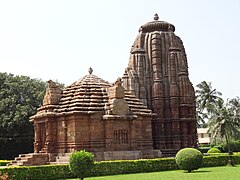Rajarani Temple
| Rajarani Temple | |
|---|---|
 |
|
| Geography | |
| Coordinates | 20°14′36.4″N 85°50′36.68″E / 20.243444°N 85.8435222°ECoordinates: 20°14′36.4″N 85°50′36.68″E / 20.243444°N 85.8435222°E |
| Country | India |
| State | Odisha |
| Location | Bhubaneswar |
| Culture | |
| Primary deity | Shiva |
| Architecture | |
| Architectural styles | Kalingan Pancharatha Style (Kalinga Architecture) |
| History and governance | |
| Date built | 11th century |
Rajarani Temple is an 11th-century Hindu temple located in Bhubaneswar, the capital city of Odisha (Orissa previously), India. The temple is believed to have been known originally as Indreswara. It is locally known as a "love temple" because of the erotic carvings of women and couples in the temple. Rajarani Temple is built in the pancharatha style on a raised platform with two structures: a central shrine called the vimana (sanctum) with a bada (curvilinear spire) over its roof rising to a height of 18 m (59 ft), and a viewing hall called jagamohana with a pyramidal roof. The temple was constructed of dull red and yellow sandstone locally called "Rajarani". There are no images inside the sanctum, and hence it is not associated with a specific sect of Hinduism but broadly classified as Saivite based on the niches.
Various historians place the original construction date between the 11th and 12th centuries, and have placed it roughly belonging to the same period as the Jagannath Temple at Puri. The architecture of other temples in central India is believed to have originated with this temple, the notable ones being the Khajuraho temples and Totesvara Mahadeo temple in Kadawa. There are various sculptures in the walls around the temple, and the vimana, depicting scenes of the marriage of Shiva, Nataraja, Parvati, and include tall, slender, sophisticated nayikas in various roles and moods such as turning her head from an emaciated ascetic, fondling her child, holding a branch of tree, attending to her toilet, looking into a mirror, taking off her anklet, caressing her pet bird and playing a musical instrument. Rajarani Temple is maintained by the Archaeological Survey of India (ASI) as a ticketed monument.
Based on the sculptural architectural style, the temple is dated to the mid-11th century. Brown groups the temple along with Anant Vasudev Temple and places it around the 11th–12th centuries. Another survey of Orissa temples carried out by S. K. Saraswati in 1953 yielded a similar date. Panigrahi, who did a comprehensive analysis of Orissan temples, gives an unspecified date between Lingaraj Temple and Mukteswara Temple. Fergusson believes construction of the temple was begun by around 1105. George Michell believes the temple was built during the same time as Lingaraja Temple. Rajarani Temple roughly belongs to the same period as the Jagannath Temple at Puri. The architecture of other temples in central India originated from the temple. The notable ones in the category are the Khajuraho temples and Totesvara Mahadeo temple in Kadawa. Scholars believe based on the style that the temple might have been built by Somavamsi kings who migrated from Central Indis to Orissa during the period. Rajarani temple is maintained by the Archaeological Survey of India (ASI) as a ticketed monument.
...
Wikipedia
